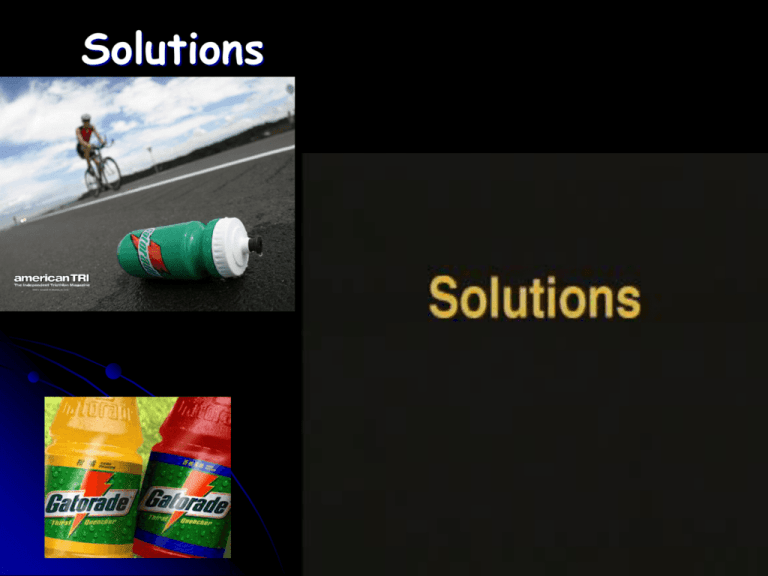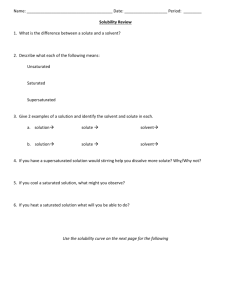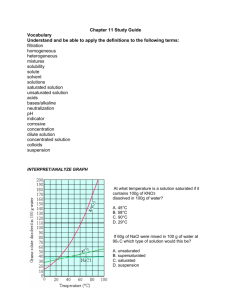Solutions1 - Trupia
advertisement

Solutions Solutions Classification are homogeneous mixtures of Matter Solute A solute is the dissolved substance in a solution. Salt in salt water Sugar in soda drinks Carbon dioxide in soda drinks Solvent A solvent is the dissolving medium in a solution. Water in salt water Water in soda Types of Solutions Solution – is a homogeneius mixture of substances in the same physical state. The substances are uniformly distributed. Can contain atoms, ions, or molecules. Solid in Solid → Brass (zinc with copper) A.K.A. Alloy Gas in Gas → Air Liquid in Liquid → Alcohol in water Solid in Liquid → Salt in water Gas in Liquid → Soda (CO2 in Water) A substance dissolved in water is known as an aqueous solution Concentrated vs. Dilute Concentrated- Having more solute particles per solvent particles. Dilute – Having more solvent particles per solute particles. Suspensions & Colloids Suspensions and Colloids Suspensions and colloids are NOT solutions. Suspensions: The particles are so large that they settle out of the solvent if not constantly stirred. Colloids: The particles intermediate in size between those of a suspension and those of a solution. The Tyndall Effect Colloids scatter light, making a beam visible. Solutions do not scatter light. Which glass contains a colloid? colloid solution Electrolytes vs. Nonelectrolytes The ammeter measures the flow of electrons (current) through the circuit. If the ammeter measures a current, and the bulb glows, then the solution conducts. If the ammeter fails to measure a current, and the bulb does not glow, the solution is non-conducting. Definition of Electrolytes and Nonelectrolytes An electrolyte is: A substance whose aqueous solution conducts an electric current. A nonelectrolyte is: A substance whose aqueous solution does not conduct an electric current. Try to classify the following substances as electrolytes or nonelectrolytes… Electrolytes? 1.Pure water 2.Tap water 3.Sugar solution 4.Sodium chloride solution 5.Hydrochloric acid solution 6.Lactic acid solution 7.Ethyl alcohol solution 8.Pure sodium chloride 9. ELECTROLYTES: NONELECTROLYTES: Tap water (weak) Pure water NaCl solution Sugar solution HCl solution Ethanol solution Lactate solution (weak) Pure NaCl But why do some compounds conduct electricity in solution while others do not…? Answers to Electrolytes Dissolution of sodium Chloride How Ionic solids dissolve H H H H H Rules for Determining Solubility Table G 1. Determining Solubility: • Saturated Solution → Point is on the line • Unsaturated Solution → Point is below the line • Supersaturated Solution → Point is above the line 2. Interpreting the graph table G •Units on the graph are grams of solute/100g of water. •If problem calls for g/200g of water or g/50g of water, double or half the grams of solute, respectively. Ex. 50g/100g of water 25g/50g of water 100g/200g of water 150g/300g of water Solubility Practice Problems 1. How many grams of NaCl are needed to make a saturated solution at 60˚C? 2. How much NaNO3 is required to make a saturated solution in 100g of water at 60˚C? In 200g of water at 60ºC? 3. How much KNO3 will precipitate out of solution when a saturated solution of KNO3 is cooled from 70˚C to 10? 4. At 60˚C what type of solution is 35g of KNO3 in 100g of water? In 50g of water? Solubility Chart Saturation of Solutions A solution that contains the maximum amount of solute that may be dissolved under existing conditions is saturated. A solution that contains less solute than a saturated solution under existing conditions is unsaturated. A solution that contains more dissolved solute than a saturated solution under the same conditions is supersaturated. Saturation and Equilibrium Solubility Trends The solubility of MOST solids increases with temperature. The rate at which solids dissolve increases with increasing surface area of the solid. The solubility of gases decreases with increase in temperature. The solubility of gases increases with the pressure above the solution. Therefore… Solids tend to dissolve best when: o Heated o Stirred o Ground into small particles Liquids & Gases tend to dissolve best when: o The solution is cold o Pressure is high Heat of Solution The Heat of Solution is the amount of heat energy absorbed (endothermic) or released (exothermic) when a specific amount of solute dissolves in a solvent. Table I Substance Heat of Solution (kJ/mol) NaOH -44.51 NH4NO3 +25.69 KNO3 +34.89 HCl -74.84 Molarity The concentration of a solution measured in moles of solute per liter of solution. mol = M L Molality The concentration of a solution in moles of solute per kilogram of solvent. mol = kg m Since the most common solvent, water, has a density of 1 kg/L, one kilogram of water is the same as one liter of water! Ways of Expressing Concentration Mass Percentage, ppm, and ppb • All methods involve quantifying amount of solute per amount of solvent (or solution). • Generally amounts or measures are masses, moles or liters. • Qualitatively solutions are dilute or concentrated. • Definitions: mass of component in solution mass % of component 100 total mass of solution mass of component in solution ppm of component 106 total mass of solution • Parts per million (ppm) can be expressed as 1 mg of solute per kilogram of solution. – If the density of the solution is 1g/mL, then 1 ppm = 1 mg solute per liter of solution. • Parts per billion (ppb) are 1 g of solute per kilogram of solution. mass of component in solution ppb of component 109 total mass of solution






